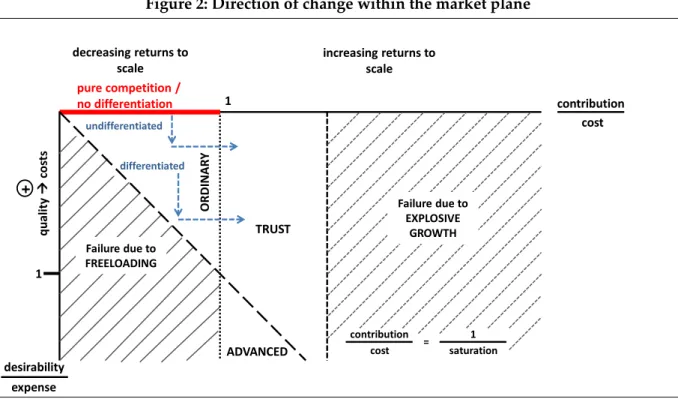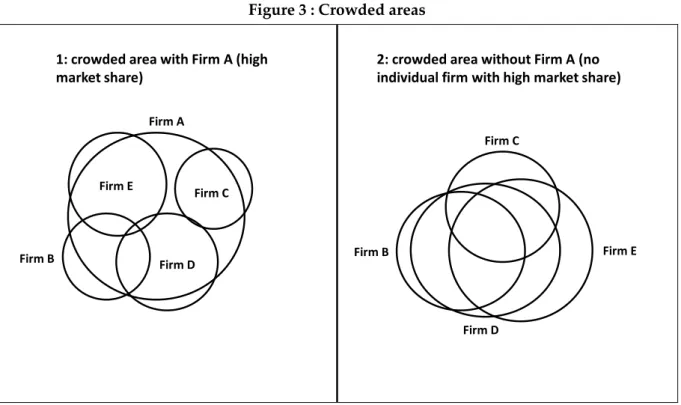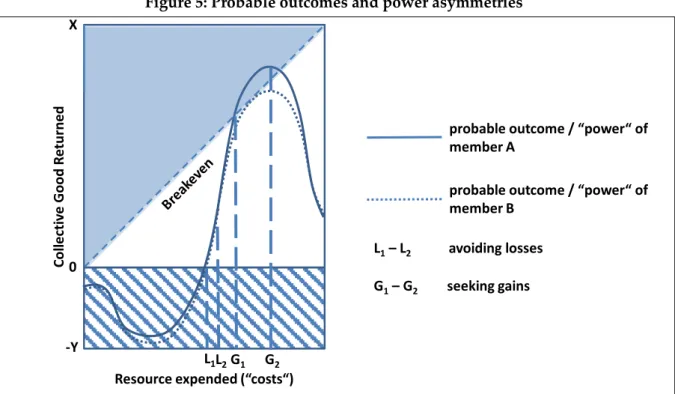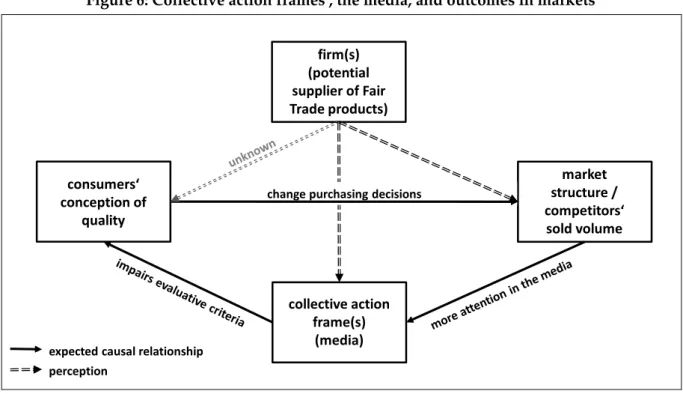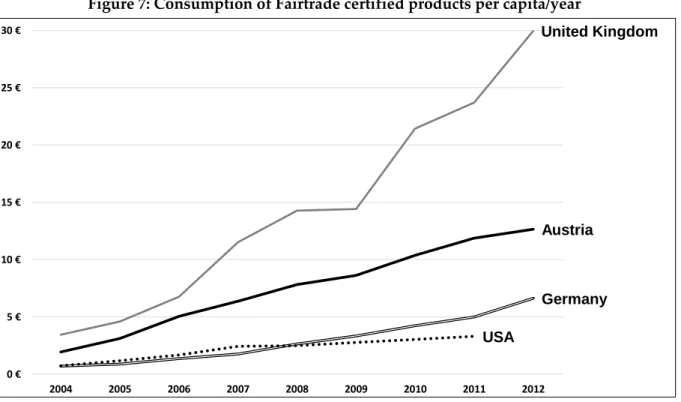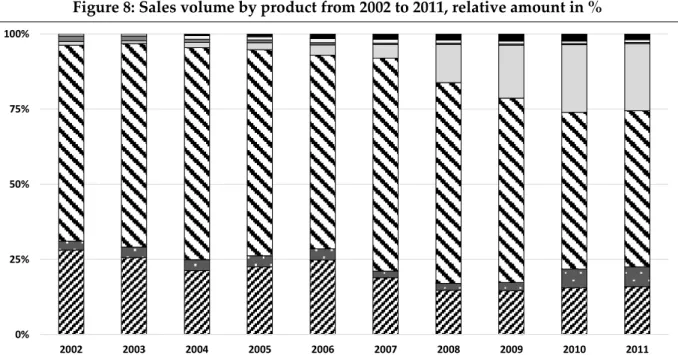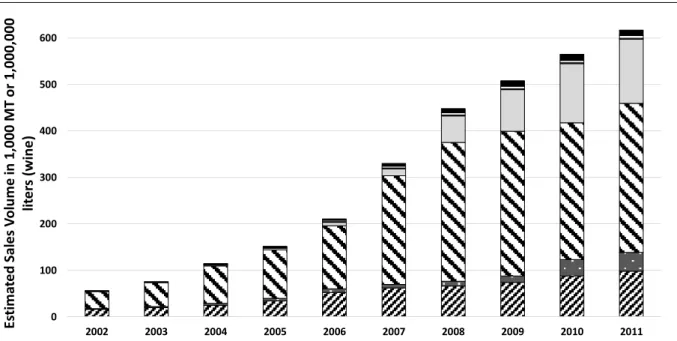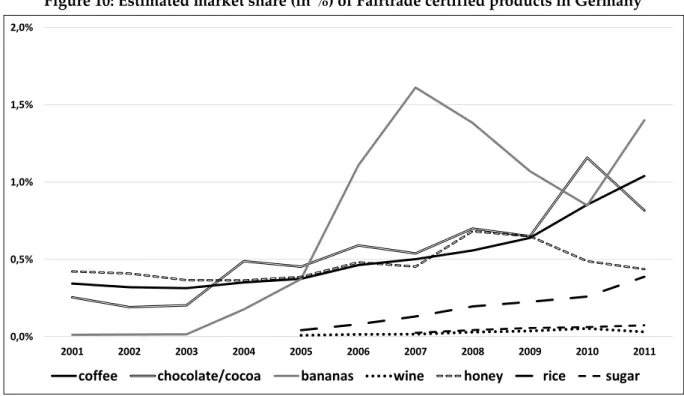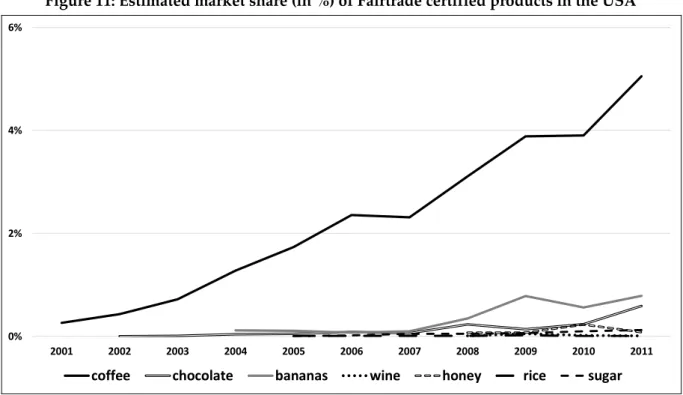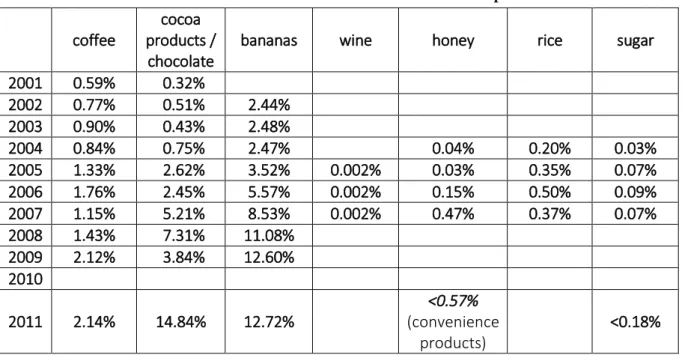Why coffee and not honey – untangling the limits and opportunities for certifying the ‘moral quality’ of products
Inauguraldissertation zur
Erlangung des Doktorgrades der
Wirtschafts- und Sozialwissenschaftlichen Fakultät der
Universität zu Köln
2017
vorgelegt von
Diplom Sozialwissenschaftler Jan-Christoph Janssen
aus
Geesthacht
Referentin: Prof. Dr. Sigrid Quack
Korreferentin: Prof. Dr. Christine Trampusch
Tag der Promotion: 29.05.2017
of products”
Acknowledgements
I would like to thank my beloved Agnes for always supporting me - especially during turbulent times of my life and while writing this thesis. I want to express my sincere gratitude to Prof. Dr.
Sigrid Quack for her constant support, advice, empathy, and patience during the past five years.
Besides I would like to thank my 2nd advisor, Prof Dr. Christine Trampusch for stepping in and her patience. For information, support, guidance and fruitful discussions I would like to thank the MPIfG Research Group “Institution Building Across Borders”, in particular Markus Lang, Dr.
Solomon Zori, Dr. Phil Mader, Jiska Gojowczyk, and Ana Carolina Alfinito Vieira. In addition, fruitful discussions especially with Prof. Dr. Ingo Rohlfing, Prof. Dr. Sebastian Koos, Prof. Dr.
Sabrina Zajak, Dr. Olga Malets, Dr. Philipp Balsinger, Prof. Dr. Carsten Schneider, Dr. Tobias Kunstein, Alexander Jerneck, and the audience at my presentations of earlier drafts at the ESA 2013 in Turin, the workshop ”Transnational Governance: Exploring New Research Avenues“
2013 in Paris, the EurSafe 2013 in Uppsala, and the SASE conference 2014 in Chicago. Those helped me to gain a new perspective on my own topic and thinking. I would like to thank all of my peer CGS fellows of the year 2011, in particular Dr. Istemi Berk and Anne Schielke. I am thankful to Prof. Dr. Clemens Kroneberg, Prof. Dr. Michael Wagner, Dr. Joel Binckli, and Dr.
Dagmar Weiler for their support during my time of writing. Special thanks to the participants of the CGS workshop for PhD students about QCA in 2015 for challenging my knowledge and discussing many topics surrounding set relational methods with me. I would like to thank Asa Ritz for helping me with language issues while writing this thesis. Finally, I would like to thank my family for their constant belief in me.
Table of Contents
1 Introduction ... 1
1.1 Research Question & Aim of the Dissertation ... 1
1.2 State of the Art & Research Gap ... 5
1.3 Structure of the Thesis ... 9
2 Theoretical Framework ... 10
2.1 Markets as (Strategic Action) Fields ... 12
2.2 Certification as Commensuration ... 18
2.3 The Outcome: The Transformation of “Markets from Networks” ... 25
2.4 Firms as Collective Actors – Talking about Incentives ... 32
2.5 Mobilizing Industries – Framing Issues and Identities ... 44
2.6 From Within – Institutional Entrepreneurship as an Endogenous Driver of change ... ... 51
2.7 From Outside - Social Movements triggering Exogenous Change ... 65
2.8 Gaining Parsimony: Final Hypotheses for the Transformation and Non-Transformation of Markets ... 77
3 An Introduction to Fair Trade ... 87
3.1 From “Alternative” to “Mainstream” ... 87
3.2 The Closed Community until 1990 ... 88
3.3 1990-2002: the Niche Market Era ... 89
3.4 Since 2002: the Mass Market Era... 91
3.5 Establishing International Bodies ... 92
3.6 Balancing Market and Ideals – Tensions of the initiative with regard to markets ... ... 93
4 Introducing the Method & the Cases – Qualitative Comparative Analysis & Dimensions of the Property Space... 97
4.1 Case Selection & Scope Conditions ... 101
4.2 The Outcome – Success of Certification as the Degree of Market Penetration ... 111
4.3 The Relevant Dimensions of the Property Space – The Conditions of Interest ... 125
4.3.1 Social Movement Organizations – Alternative Trade Organizations (ATOs) or Fair Trade Organizations (FTOs) and their relationship to national licensers ... 126
4.3.2 Screening for Incumbents ... 140
4.3.3 Analysis of Collective Action Frames: Framing Fair Trade ... 162
4.3.4 Visibility or media attention of single organizations ... 183
5 The Analysis and Evaluation of Theoretical Arguments ... 205
5.1 The Location of Cases in the Property Space and an Assessment of (Dis-) Similarity .. 205
5.2 The Choice for QCA and a Suitable Solution Term – Assessing Dependencies among Dimensions of the Property Space ... 213
5.3 Test for Necessity for the Outcome (Market Penetration) and its Negation ... 227
5.4 fsQCA of a High Degree of Market Penetration ... 228
5.4.1 Analysis with five Conditions and the Outcome ... 228
5.4.2 Analysis with four Conditions and the Outcome ... 232
5.4.3 The Evaluation of the theoretical arguments for the Outcome ... 240
5.5 fsQCA of a Low Degree of Market Penetration ... 244
5.5.1 Analysis with four Conditions and the Non-Outcome ... 245
5.5.2 Evaluating SUIN-conditions for the Non-Outcome ... 251
5.6 Single Cases for a Closer Look ... 257
5.6.1 Deviant case for coverage compared to individually irrelevant case: coffee and cocoa in the USA ... 261
5.6.2 Crucial (Least Likely) Case ... 264
5.6.3 Typical Cases... 266
5.7 Interpretation of the Results Beyond the Limits of Fuzzy-set Qualitative Comparative Analysis ... 273
6 Conclusion ... 280
6.1 Theoretical and Empirical Contributions ... 281
6.1.1 Contributions to the Literature on Social Movements and Institutional
Entrepreneurship ... 281
6.1.2 Contributions to the field of “Ethical” and “Political Consumerism” and Fair Trade ... 283
6.1.3 Methodological Contributions to fsQCA – Dependencies among the Conditions and Stronger Reliance on Theories ... 284
6.2 Drawbacks and Directions for Future Research ... 285
6.2.1 Future Research on Fair Trade ... 286
6.2.2 Fallacies of QCA – Opening the “Black Box” ... 288
6.2.3 Expanding the Scope of the Theoretical Argument ... 288
7 Bibliography ... 291
8 Appendix ... 327
8.1 The concentration of industries with regard to product categories ... 327
8.1.1 Coffee ... 327
8.1.2 Cocoa ... 334
8.1.3 Wine ... 342
8.1.4 Honey ... 350
8.1.5 Rice ... 355
8.1.6 Sugar ... 361
8.1.7 Bananas ... 365
8.2 Components of Collective Action Frames in detail ... 373
9 Curriculum Vitae ... 382
List of Tables
Table 1: Products launches by year ... 116 Table 2: Estimated market share (in %) of Fairtrade certified products in Austria ... 120 Table 3: Estimated market share (in %) of Fairtrade certified products in the United Kingdom . 122 Table 4: Sales of Fairtrade certified products in million GPB (£) ... 123 Table 5: Calibration procedure fort the degree of market penetration by market share ... 124 Table 6: Calibrated degree of set membership for the outcome Market penetration by product market and national context ... 125 Table 7: Calibrated degree of set membership of the set ATO (the importance of Alternative Trade channels compared to the national licensing initiatives) ... 140 Table 8: Combined market share of the major companies by product category and national context over time (2002 to 2014), concentration ratios (CR) for the major five (CR5), major four (CR4), and major three (CR3) companies ... 154 Table 9: Combined market share of major companies by national context for sugar and bananas, qualitative assessment ... 155 Table 10: Calibration procedure for the sets Companies_CR and Supermarkets_CR: market share of major companies or super- and hypermarket chains, by concentration ratio (CR-value) ... 157 Table 11: Calibrated degree of set membership for Supermarkets_CR (the concentration of the retail sector) by national context based on the concentration ratio (CR5, CR4, or CR8), i.e. the combined market share of the major five, four, or eight super- and hypermarket chains ... 157 Table 12: Calibrated degree of set membership for the set Companies_CR (the concentration of industries) by national context and product category based on the concentration ration (CR3), i.e.
the combined market share of the major three companies ... 158 Table 13: Calibrated degree of set membership for the set Incumbents as the minimum set membership of the concentration of the retail sector (Supermarkets_CR) by national context and the industries (Companies_CR) by national context and product category ... 160 Table 14: Calibration procedure for the set Framing: % of articles with “Collective Action Frame(s)“ by product category and national setting to all articles with “Collective Action Frames“
within the respective national setting ... 180 Table 15: Calibrated degree of set membership for the set Framing: % of articles with “Collective Action Frame(s)“ by product category and national setting to all articles with “Collective Action Frame(s)“ within the respective national setting ... 181
Table 16: Calibration procedure for the set Visibility: uneven distribution of articles with regard to firms / uneven media attention on single firms, “Gini Top 1“ ... 202 Table 17: Calibrated degree of set membership for the set set Visibility: uneven distribution of articles with regard to firms / uneven media attention on single firms, “Gini Top 1“ ... 203 Table 18: Degree of set membership in the outcome and in the five conditions (fuzzy set scores) ... 207 Table 19: Crisp set membership in the outcome and in the 5 conditions (crisp set scores) ... 210 Table 20 . Boolean Distances to compare the 28 cases (maximum: 5, minimum: 0)... 212 Table 21: Example for simplifying assumptions with 2 conditions and one empty truth table row ... 216 Table 22: Example for simplifying assumptions with 2 conditions and one empty truth table row, example: welfare state ... 220 Table 23: Evaluating deterministic dependencies / subset- and superset relations among the five conditions ... 223 Table 24: Screening for necessary conditions for Market Penetration and its negation, consistency and coverage of the conditions as a superset of Market Penetration and ist negation (outcome and non-outcome) ... 227 Table 25: Truth table for the analysis of the outcome (Market Penetration) with 5 conditions .... 229 Table 26: Complex and intermediate solution for the analysis of the outcome (Market Penetration) with 5 conditions... 230 Table 27: Degree of set membership in the outcome and in the 4 conditions (fuzzy set scores) .. 234 Table 28: Evaluating deterministic dependencies / subset- and superset relations among the set Incumbents and the remaining 3 conditions ... 235 Table 29: Truth table for the analysis of the outcome (Market Penetration) with 4 conditions .... 236 Table 30: Intermediate solution for the analysis of the outcome (Market Penetration) with 4 conditions ... 237 Table 31: Complex solution for the analysis of the outcome (Market Penetration) with 4 conditions ... 238 Table 32: Parsimonious solution for the analysis of the outcome (Market Penetration) with 4 conditions ... 238 Table 33: Degree of set membership in the outcome, in the 4 conditions, and in the two hypothesized paths to the outcome: (Incumbents ∧ Faming ∧ ATO) ∨ (Incumbents ∧ Framing ∧ Visibility) (fuzzy set scores) ... 242
Table 34: Truth table for the analysis of the outcome (Market Penetration) with the hypothesized equifinal paths (Social Movements and Institutional Entrepreneurs) as single conditions... 243 Table 35: Complex / intermediate / parsimonious solution for the analysis of the outcome (Market Penetration) with the hypothesized equifinal paths (Social Movements and Institutional Entrepreneurs) as single conditions ... 244 Table 36: Degree of set membership in the non-outcome and in the 4 conditions (fuzzy set scores) ... 246 Table 37: Truth table for the analysis of the non-outcome (Non-Market Penetration) with 4 conditions ... 247 Table 38: Intermediate and parsimonious solution for the analysis of the non-outcome (Non- Market Penetration) with 4 conditions ... 248 Table 39: Complex solution for the analysis of the non-outcome (Non-Market Penetration) with 4 conditions ... 249 Table 40: Screening for SUIN-causes of the non-noutcome (Non-Market Penetration) ... 252 Table 41: Comparison of different potential SUIN-causes (different indicators of relevance / trivialness) ... 254 Table 42: Screening for the necessity among the single most important parts of the SUIN- combinations in Table 40 and Table 41 ... 256 Table 43: intersections of theory (T) and solution term (S) with types of cases ... 258
List of Tables (Appendix)
Table A 1: Combined market share of the major 5, major 4, and major 3 companies - concentration ratios (CR5, CR4, CR3) of coffee in Austria ... 329 Table A 2: Combined market share of the major 5, major 4, and major 3 companies - concentration ratios (CR5, CR4, CR3) of coffee in Germany ... 331 Table A 3: Combined market share of the major 5, major 4, and major 3 companies - concentration ratios (CR5, CR4, CR3) of coffee in the United Kingdom ... 332 Table A 4 . Combined market share of the major 5, major 4, and major 3 companies - concentration ratios (CR5, CR4, CR3) of coffee in the USA ... 333 Table A 5: Combined market share of the major 5, major 4, and major 3 companies - concentration ratios (CR5, CR4, CR3) of chocolate confectionaries and chocolate spreads in Austria ... 337 Table A 6: Combined market share of the major 5, major 4, and major 3 companies - concentration ratios (CR5, CR4, CR3) of chocolate confectionaries and chocolate spreads in Germany ... 338
Table A 7: Combined market share of the major 4 and major 3 companies - concentration ratios (CR4 and CR3) of chocolate confectionaries and chocolate spreads in the United Kingdom ... 340 Table A 8: Combined market share of the major 5, major 4, and major 3 companies - concentration ratios (CR5, CR4, CR3) of chocolate confectionaries and chocolate spreads in the USA ... 342 Table A 9: Combined market share of the major 5, major 4, and major 3 companies - concentration ratios (CR5, CR4, CR3) of wine (still, sparkling, fortified, champagne), still & sparkling wine, and still wine in Austria ... 345 Table A 10: Combined market share of the major 5, major 4, and major 3 companies - concentration ratios (CR5, CR4, CR3) of wine (still, sparkling, fortified, champagne), still &
sparkling wine, and still wine in Germany ... 346 Table A 11: Combined market share of the major 5, major 4, and major 3 companies - concentration ratios (CR5, CR4, CR3) of wine (still, sparkling, fortified, champagne), still &
sparkling wine, and still wine in the United Kingdom ... 348 Table A 12: Combined market share of the major 5, major 4, and major 3 companies - concentration ratios (CR5, CR4, CR3) of wine (still, sparkling, fortified, champagne), still &
sparkling wine, and still wine in the USA ... 349 Table A 13: Combined market share of the major 4 and major 3 companies - concentration ratios (CR4 and CR3) of honey (spread) in Austria ... 352 Table A 14: Combined market share of the major 4 and major 3 companies - concentration ratios (CR4 and CR3) of honey (spread) in Germany ... 353 Table A 15: Combined market share of the major 3 companies - concentration ratio (CR3) of honey (spread) in the United Kingdom ... 354 Table A 16: Combined market share of the major 4 and major 3 companies - concentration ratios (CR4 and CR3) of honey (spread) in the USA ... 354 Table A 17: Combined market share of the major 3 companies - concentration ratio (CR3) of rice in Austria... 358 Table A 18: Combined market share of the major 5, major 4, and major 3 companies - concentration ratios (CR5, CR4, and CR3) of rice in Germany ... 359 Table A 19: Combined market share of the major 4 and major 3 companies - concentration ratios (CR4 and CR3) of rice in the United Kingdom ... 360 Table A 20: Combined market share of the major 5, major 4, and major 3 companies - concentration ratios (CR5, CR4, and CR3) of rice in the USA ... 361
Table A 21: All articles with diagnostic, prognostic, and motivational components of "Collective Action Frame(s)" by national context, absolute amount and % to all articles with any framing component ... 374 Table A 22: All articles with diagnostic, prognostic, and motivational components of "Collective Action Frame(s)" by national context and product category, absolute amount and % to all articles with any framing component ... 376 Table A 23: All artricles with diagnostic, prognostic, and motivational components of “Collective Action Frame(s)” by national context, absolute amount and % to all articles with “Collective Action Frame(s)“ ... 380
List of Figures
Figure 1: Strategic action field according to Fligstein and McAdam (2011, 2012) ... 17
Figure 2: Direction of change within the market plane ... 30
Figure 3 : Crowded areas... 34
Figure 4: Acceptable net returns for different kind of actors ... 38
Figure 5: Probable outcomes and power asymmetries ... 41
Figure 6: Collective action frames , the media, and outcomes in markets ... 49
Figure 7: Consumption of Fairtrade certified products per capita/year ... 106
Figure 8: Sales volume by product from 2002 to 2011, relative amount in % ... 110
Figure 9: Sales volume by product from 2002 to 2011, absolute amount in 1,000 MT or 1,000,000 liters ... 111
Figure 10: Estimated market share (in %) of Fairtrade certified products in Germany ... 118
Figure 11: Estimated market share (in %) of Fairtrade certified products in the USA ... 119
Figure 12: ATO sales to FLO sales in % ... 133
Figure 13: Worldshop sales to FLO sales in % ... 134
Figure 14: Sales of major European Fair Trade Organizations (FTOs) in million Euros ... 135
Figure 15: Sales of major European Fair Trade Organizations (FTOs) in relation to the sum of FTO and FLO sales combined (in %) ... 136
Figure 16: Combined market share of major super- and hypermarket chains by national contexts over time (2003 to 2013), concentration ratios (CR) of the major five (CR5), major four (CR4), or major eight (CR8) super- and hypermarket chains ... 144
Figure 17: Market share of private labels to all grocery retail (value) by national context and over time (2001 to 2013) ... 146
Figure 18: All articles with and without Framing Components and “Collective Action Frames“ from 1991 to 2011, absolute number ... 171
Figure 19: All articles with and without Framing Components and “Collective Action Frames“ by national context, absolute frequencies and amount of articles with ”Collective Action Frames“ in % to all articles within the respective national context ... 172
Figure 20: "Collective Action Frames" by product category and national context in % to all articles with "Collective Action Frames" within the respective national context ... 174
Figure 21: Articles with "Collective Action Frame(s)" in Austria by product category over time (1996 to 2011) and year of passing the threshold of 1% market share, absolute frequencies ... 176
Figure 22: Articles with "Collective Action Frame(s)" in Germany by product category over time (1998 to 2011) and year of passing the threshold of 1% market share, absolute frequencies ... 177
Figure 23: Articles with "Collective Action Frames" in the United Kingdom by product category over time (1994 to 2011) and year of passing the threshold of 1% market share, absolute frequencies... 178 Figure 24: Articles with "Collective Action Frame(s)" in the USA by product category over time (1996 to 2010) and year of passing the threshold of 1% market share, absolute frequencies ... 179 Figure 25: Uneven distribution of articles with regard to firms, "simple Gini index" (example coffeee in the United Kingdom) ... 185 Figure 26: Uneven distribution of articles with regard to firms, "simple Gini index" for all product categories by national context ... 186 Figure 27: Uneven distribution of articles with regard to firms / uneven media attention on single firms, "Gini Top 3", “Gini Top 2“, “Gini Top 1“ (example coffee in the United Kingdom) ... 188 Figure 28: Uneven distribution of articles with regard to firms / uneven media attention on single firms in Austria, "Gini Top 3", “Gini Top 2“, “Gini Top 1“ ... 192 Figure 29: Uneven distribution of articles with regard to firms / uneven media attention on single firms in Germany, "Gini Top 3", “Gini Top 2“, “Gini Top 1“ ... 193 Figure 30: Uneven distribution of articles with regard to firms / uneven media attention on single firms in the United Kingdom, "Gini Top 3", “Gini Top 2“, “Gini Top 1“ ... 194 Figure 31: Uneven distribution of articles with regard to firms / uneven media attention on single firms in the USA, "Gini Top 3", “Gini Top 2“, “Gini Top 1“ ... 195 Figure 32: XY plot of the 28 cases in the complex / intermediate solution term and the outcome (Market Penetration) (analysis with 5 conditions) ... 231 Figure 33: XY plot of the 28 cases in the intermediate solution term and the outcome (Market Penetration) (analysis with 4 conditions) ... 240 Figure 34: XY plot of the 28 cases in the intermediate and parsimonious solution term and the non-outcome (Non-Market Penetration) (analysis with 4 conditions) ... 250 Figure 35: Enhanced XY plot and types of cases in fsQCA of sufficiency (intermediate solution of the analysis of the outcome) ... 259 Figure 36: Number of licensed companies selling Fairtrade certified coffee in Germany from 2000 to 2010 ... 268 Figure 37: synchronic interpretation of the 2 detected paths ... 278 Figure 38: diachronic interpretation of the 2 detected paths ... 279 List of Figures (Appendix)
Figure A 1: Market share of major companies (bananas) over time in %, global exports ... 367
Figure A 2: Market share of major companies (bananas) over time in %, global imports ... 368 Figure A 3: Market share of major companies (bananas) over time (1992 to 2003) in %, imports (into the European Community) ... 369 Figure A 4: Market share of major companies (bananas) over time (2006 to 2013) in %, imports (into the European Community) ... 371 Figure A 5: Market share of major companies over time (2006 to 2013) in %, imports (into the European Community) ... 371 Figure A 6: All articles with "Collective Action Frame(s)" by national context from 1994 to 2011, absolute amount ... 379
1 Introduction
1.1 Research Question & Aim of the Dissertation
In recent decades, the “retreat of the state” (Strang, 1996) has changed the landscape of power relations in the world economy in favor of private and non-governmental actors. They increasingly fulfil regulative functions with regard to markets, their externalities for the environment, and the terms of production (Bartley, 2007b, 2010; Bartley & Smith, 2010). This process has been accompanied or coincided with the segmentation of consumer markets by issues perceived as being moral. Several consumer products allow for distinctions and segmentation on moral dimensions. Consumers decide whether they prefer “grass fed” meat and dairy products (K. Weber et al., 2008), organic (Allen & Kovach, 2000; Goodman & DuPuis, 2002), Fairtrade certified (Archer & Fritsch, 2010; Raynolds, 2000), locally produced (Pietrykowski, 2004), eco-friendly (Pastakia, 1998), or conventionally produced goods. In particular, organic and Fair Trade denote visible and relevant segments in mainstream markets (European Commission, 2014 [10/03/2014]; Potts et al., 2014a, 2014b, 2014c). Certificates and labels are a visible cue to demarcate those segments and are employed for supply chains within and across national borders.
“Transnational private certification” aims at re-embedding capitalism (in the sense of Polanyi, 2001 [1944]) through standard setting by private means (Bartley, 2007b, p. 297f). Similar to earlier attempts of “moral economies” (Bolton & Laaser, 2013; Thompson, 1971)1, private certification issues moral dimensions of market exchange. Even though moral struggles are inclined to shape markets (Beckert, 2011; Bolton & Laaser, 2013), morality is hardly homogeneous or consensual and is constantly constructed and reconstructed by various groups in societies (Beckert, 2011, p.
4ff; Bolton & Laaser, 2013, p. 515). Morality accompanies markets and, especially, consumption by shaping individual preferences, which allows for a strong degree of diversity within society (Beckert, 2011, p. 4f). A closer look at consumption patterns reveals the increasing importance of certificates and third party monitoring for ethical or political consumers and different predictors on the micro-level (Andorfer, 2013; Andorfer & Liebe, 2012; Koos, 2012; D. V. Shaw & Shiu, 2002).
Even if various moral standards are codified in different standards, labels, and certificates, the
1 Despite Polanyi’s (2001 [1944]) focus on the state as the sole pivotal agent, Thompson (1971) shows that the “crowd” plays a strong role in moralizing the economy or establishing a “moral economy (of the crowd)” in 18th centuries England (Bolton &
Laaser, 2013, p. 513). Thompson (1971) shows that the “crowd” fought for “legitimate” means and goals in the sense that those
“were supported by the wider consensus in the community” (Thompson, 1971, p. 78). Action was “grounded upon a consistent traditional view of social norms and obligations, of the proper economic functions of several parties within the community, which, take together, can be said to constitute the moral economy of the poor. An outrage to these moral assumptions, quite as much as actual deprivation, was the usual occasion for direct action” (Thompson, 1971, p. 79).
capabilities of consumers to process and evaluate this information accordingly is rather limited (Valor, 2008). How do consumers decide which kind of moral issue is relevant for which kind of product? Why are small scale producers and the Fairtrade certification mark relatively important for coffee, while organic labels are important for eggs, for instance.
Many scholars change the angle to the evolution and governance structure of certification initiatives or the opportunities of certification initiatives and social movements to shape the incentives of commercial enterprises – either to source certified or “morally favorable” goods and practices or to shy away from uncertified or “morally unfavorable” goods and practices (Bartley, 2007a, 2007b, 2010, 2014; Bartley & Child, 2011, 2014; Schurman, 2004; Schurman & Munro, 2009).
Insights into the variation of “success” between certification marks2 can neither rely on consumer attitudes nor on economic incentives for commercial enterprises, alone (Bartley, 2007b). Many scholars compare the governance structure (Bartley & Smith, 2010; Bethge, 2014), impact on the practices of production and sourcing (Bethge, 2014; P. L. Taylor, 2004), and amount of certified volume (Potts et al., 2014a, 2014b, 2014c) of different certificates. but do not address why this particular moral issues gains relevance for this particular product. Thus, what makes the difference between certification marks which take momentum in mainstream markets and those that don’t make it?
Possible answers to this question include the appeal and convincingness of criteria issued or the radicalness of the initiative (Bartley, 2007a, p. 229; K. Weber et al., 2008, p. 560), as well as the criteria and their fit to the moral understanding of the increasing audience of “ethical” or
“political consumers” (Gourevitch, 2011; Koos, 2012; D. V. Shaw et al., 2006; D. V. Shaw & Shiu, 2002)3. Functional explanations or the “market based approach” (Bartley, 2007b) would regard
“market failure” and cooperation between firms as the driving force behind certification marks that inform consumers and address those failures in certain industries (Nicholls & Opal, 2005, p.
33ff). The characteristics of the initiatives – e.g. their relationship and reliance on foundations (Bartley, 2007a) and the state (Bartley, 2010, p. 4) that establish “fields of governance” (Bartley, 2010, p. 4) – might be pivotal, as well. Given that the ascendance of transnational certification is an “evolving transnational institution building project” (Bartley & Smith, 2010, p. 348), the impact or degree of institutionalization across national settings and “across issue domains” (Bartley &
2 Certification marks in this thesis comprise voluntary programs that are market based and provide information as the main measure of regulation – those are regarded as a form of “soft law” (Bartley, 2010, p. 4ff).
3 Another stream of literature explains the increasing significance of certification marks with the self-interest of the consumers, who maximize their utility – certification marks can be related to the quality (e.g. health) (Botonaki et al., 2006; Magnusson et al., 2003). Political consumption can also be related to “private concerns” (health, nutrition) of consumers, especially women (Micheletti, 2003, p. 44). Thus, the chosen certification mark issues only the terms of production – with regard to quality, only the moral quality distinguishes certified from uncertified products.
Smith, 2010, p. 366ff) should be considered. This thesis rules out those potential answers by focusing on one single certification mark from a comparative angle across product categories or
“issue domains” (Bartley & Smith, 2010, p. 366ff). The impact is compared across seven products and four national contexts. Therefore, the initial question has to be reformulated to:
“What makes the difference between the “success” of this certification mark in this particular product market within this national setting and the “failure” of the same certification mark in that particular context within that national setting?”
The case - Fair Trade4 - can be regarded as promising in this regard. While the certification mark hit mainstream markets rather effectively and with increasing scale (e.g. FLO, 2010b, 2011c;
Warrier, 2011b), a high variance across national contexts and product categories hampers the interpretation of Fair Trade as a general success without reservations. Even among the rather successful national initiatives considered in this thesis, a strong variation can be detected. In 2007, Germans paid 1.72 € per capita (on average) for Fair Trade products, while British people paid 11.89 € for Fair Trade products per capita (on average) in the same year (Schaber & van Dok, 2008, p. 37) – separating these two rather successful, similarly mature, and relevant national settings by a factor of seven in 2007. By looking at the two most extreme examples in the study of Schaber and van Dok (2008, p. 37) for 2007 – Japan (0.05 € per capita, on average) and Switzerland (20.88 € per capita, on average) – the factor 417.6 lies in between the sales of Fair Trade products.
This variance is mirrored for product categories. On global scale, the labeled volume of the rather mature product honey doubled (also due to new national labeling initiatives) from 2002 (FLO, 2004, p. 3) to 2,070 MT in 2011 (FLO, 2004, p. 3; 2012a, p. 13). In the same time period, the certified volume of coffee rose from 15,779 MT to 98,073 MT (by about 522%), cocoa rose from 1,656 MT to 40,198 MT (by about 2,327%), and bananas rose from 36,641 MT to 320,923 MT (by about 776%) (comparison of FLO, 2004, p. 3 and ; 2012a, p. 13, own estimation). Even if the raw numbers do not allow for a straightforward comparison, the differences of the growth rates are striking and cannot be explained with reference to the certification mark, alone.
4 In this thesis, the term “Fair Trade“ refers to the general notion of “Fair Trade“ which encompasses the certification approach by FLO and other similar attempts by social movements (e.g. Alternative Trade Organizations (ATOs), Fair Trade Organizations (FTOs), and Worldshops) as long as they are connected to the organization FINE. The term “Fairtrade“ refers exclusively to products carrying the Fairtrade certification mark.
In contrast, my explanation of these differences relies on the interplay of ideational as well as structural conditions (see: McAdam et al., 2001, p. 310 for a similar approach)5. Framing (Benford
& Snow, 2000; Gamson, 1990 [1975], 2004) and disruptive tactics by movements and entrepreneurs (Bartley & Child, 2014; Dubuisson-Quellier, 2013b; King & Pearce, 2010; King &
Soule, 2007; Schurman, 2004; Schurman & Munro, 2009) as well as structural characteristics of the social movements and the degree of incumbency (Fligstein & McAdam, 2011, 2012) as characteristics of the supply or value chain (Gereffi et al., 2005; Gereffi & Korzeniewicz, 1994;
Gereffi & Lee, 2016) are analyzed in concert for a comparative understanding of the success of certification. I analyze seven product categories (coffee, cocoa, bananas, sugar, rice, wine, and honey) carrying the certification mark or label in four national contexts (Austria, Germany, the United Kingdom, and the USA) to detect paths to high and low degrees of market penetration with regard to sufficiency – as Bartley (2007b, p. 314) proposes.
This thesis contributes to the literature by:
- Providing a comparative framework for social movements, institutional entrepreneurship, and certification that is currently regarded as a blind spot or new direction by Battilana et al. (2009, p. 95), Amenta (2014, p. 17), Rao et al. (2000, p. 278), Schurman and Munro (2009, p. 196), Bartley (2007b, p. 314), Koenig-Archibugi and Macdonald (2013, p. 518f), and McLeod et al. (2016, p. 439).
- Improving the understanding of the interplay between incumbency (Fligstein &
McAdam, 2011, 2012) as a pivotal and often analyzed characteristic of the supply chain (Gereffi et al., 2005; Gereffi & Korzeniewicz, 1994; Gereffi & Lee, 2016) in the explanation of the effects of certification (e.g. Fisher, 2009; Gandenberger et al., 2011; Jaffee, 2010;
Raynolds, 2012, p. 277; Reed, 2009; S. Smith, 2010b; Tallontire, 2009) with ideational factors
- Offering an opportunity to theorize and compare processes through the constitutive (Wendt, 1998) and necessary parts (Goertz, 2005) of certain (assumed) mechanisms
5 McAdam et al. (2001, p. 310) argue for a combination of mechanisms and processes in their explanation of social movements’
outcomes. However, they explicitly argue against sufficiency/necessity and set relational approaches, which (according to their argument) should be abandoned. From their perspective, a mechanism centered approach is compelling for an explanation and comparison of different mechanisms (and the presence of “markers”) and common processes across cases (McAdam et al., 2001, p. 312).
1.2 State of the Art & Research Gap
The importance of moral considerations in guiding decisions of market participants is acknowledged by scholars across disciplines. For instance, behavioral economics provides experimental evidence that institutions sanctioning uncooperative behavior are favored over non-sanctioning ones (Gürerk et al., 2006) and demonstrates how economic incentives may undermine moral ones (Bowles, 2008). Sociological claims that consider the moral foundations of diverse sets of outcomes on the individual (M. Weber, 1978 [1921]), as well as the collective level (Durkheim, 1992 [1893]) can be traced back to the founding fathers of the discipline (for a review:
Beckert, 2011; Fourcade & Healy, 2007). Within national settings, the state does have an important role in incorporating moral codes into the legal system and in resolving conflicts about moral issues (Sassen, 2003). Moral issues of inter- or transnational scope lack these kind of identifiable central authorities (Börzel & Risse, 2010; Mueckenberger & Jastram, 2010). In contrast to other entities, states aggregate the interests and opinions of various groups (E. T. Walker et al., 2008, p. 40f), which link them to moral discourses within societies, and they are able to enforce their decisions effectively (Börzel & Risse, 2010, p. 127). Private transnational certification that aims at the enforcement of standards, which are perceived as inherently moral, might be able to fill this supposed regulatory void under certain circumstances (Börzel & Risse, 2010).
Like other forms of collective identity (Anteby, 2010; Lounsbury et al., 2003; Wry et al., 2011), moral standards (due to certification, for instance) consist of general ideas of abstract nature to express this identity or ideology as a distinguishing feature (Bartley & Smith, 2010; Bergeron et al., 2014), and specific regulations which can be evaluated and monitored by third parties (Bartley, 2010; Malets, 2011). These specific regulations are derived from the general claims and have to be adjusted to be applicable to specific contexts (Bartley, 2010; Malets, 2011). In this process, products and practices are getting interlinked or commensurated through the moral code. Commensuration is understood as the process of transforming “different qualities into a common metric” (Espeland & Stevens, 1998, p. 314). “[It] is fundamentally relative [and] it creates relations between attributes where value is revealed in comparison” (Espeland & Stevens, 1998, p. 317). Particularly if it involves moral judgments, commensuration is a social process as contested as morality itself (Fourcade, 2011). The process of commensuration involves coalition building, promotion efforts, and compromises (Huault & Rainelli-Weiss, 2011).
While cases in which markets had to transcend moral boundaries are well known (Anteby, 2010;
Satz, 2010; Zelizer, 1978, 1981), moral claims themselves have to transcend potential market boundaries (Bergeron et al., 2014). In many instances, the certification of ethical codes has its
origins in bottom up social movements or communities outside the market (Bartley, 2007b;
Bartley & Smith, 2010; Fourcade & Healy, 2007, p. 304). This finding clearly contradicts any attempt to understand those forms of market accompanying morality (Beckert, 2011) in considering merely the behavior of market participants – consumers as well as firms (Holt, 2012). Bartley convincingly shows that “interested actors within the market” as well as “entrepreneurial actors within the organizational field” can be regarded as potentially relevant conditions for the creation of successful certification schemes (Bartley, 2007b, p. 339). Thus, an understanding of morality accompanying markets through certification has to regard the involvement of both kinds of actors as potentially necessary conditions. In the following section, the role of market and non- market actors is fleshed out in more detail.
Following the argument of Zelizer, criteria to evaluate morality like certification standards are formulated either as a response to internal crisis, as a result of modeling on prestigious exemplars, or they are enforced by external authorities (Zelizer, 2007, p. 14ff). While Zelizer differentiates sharply between those three circumstances for the formation of ethical codes, one may consider the possibility that those forces act in concert. Internal crisis lays a fruitful ground for external pressure to affect vulnerable organizations, while emulation may lead to the diffusion of ethical codes between organizations. Both, the argument for morality in the analysis of markets by Beckert (2011), as well as the political cultural approach proposed by Fligstein and Mc Adam (2011) and applied by Bartley (2007a, 2007b) to transnational private certification, converge around the contested nature of markets as fields6. The contentious nature of markets (King &
Pearce, 2010) shifts the focus away from frameworks which explain homogeneity in supposing isomorphic forces or rationalized myths (DiMaggio & Powell, 1983; Meyer & Rowan, 1977). At least two overlapping lines of research can be identified, which take markets as arenas of contestation into account.
Firstly, many scholars presume and analyze the behavior of (institutional) “entrepreneurs”.
Those “entrepreneurs” exploit the opportunities given by and act strategically within a given institutional structure (Beckert, 1999; Greenwood & Suddaby, 2006; Hung & Whittington, 2011).
Besides the paradox of “embedded agency” (Beckert, 1999), those “entrepreneurs” can hardly be detected ex ante and appear as “heroes” (Lounsbury & Crumley, 2007, p. 993). For instance, their
6 Even though there is hardly only one theory of “fields“ (Levi Martin, 2003), Beckert and Fligstein both draw on the work of Bourdieu (2005 [2000]). They conceptualize fields as arenas of power relations and contestation. Fields are “the historical result of struggles in which they [firms or other affected parties - author’s note] attempt to defend or improve their position in the field by both defending existing structures and changing these structures to realize new opportunities” (Beckert, 2010, p. 620).
Beckert (2010) emphasis the need to analyze the complex interrelations of networks, institutions, and cognitive frames to analyze field level change. In contrast, Fligstein and McAdam (2011) focus more narrowly on the opportunity structure of challengers to oppose the dominant institutional logic which fosters the reproduction of incumbents’ position.
positions either as fringe (Castel & Friedberg, 2010) or dominant players (Greenwood & Suddaby, 2006; Hung & Whittington, 2011) vary tremendously between studies.
Secondly and as an alternative framework, the inclusion of social movements in the analysis of markets aids in overcoming the fallacies by highlighting conflicts with an emphasis on collective action and its specific preconditions and outcomes (Campbell, 2005; King & Pearce, 2010;
Lounsbury et al., 2003). Social movements are able to align and aggregate various interests to induce long lasting change in markets and surpass national boundaries (King & Pearce, 2010).
In a nutshell, morality accompanies markets through the action of social movements raising moral issues and enlarging potential audiences (King & Pearce, 2010; Lounsbury et al., 2003) as well as through the strategic or incidental behavior of firms applying the moral codes to improve or sustain their relative position in front of others (Beckert, 2011; van Wijk et al., 2013). Indeed, the struggle over relative positions includes coalition building and linguistic efforts to establish and communicate a visible and convincing collective identity to audiences (Fligstein, 2001b; Fligstein
& McAdam, 2011; Hung & Whittington, 2011; K. Weber et al., 2008). K. Weber et al. (2008) show, how moral categories can be utilized by social movements and firms to establish a visible niche to overcome the predominant understanding of quality in the market for dairy and meat products.
They suggest that the characteristics of cultural codes are pivotal for an understanding of success and failure. Codes have to be appealing to the movement and in line to the goals and means of certain firms in the market (K. Weber et al., 2008). From their viewpoint, moral codes have to be flexible, inclusive, and articulated by reformist actors to successfully affect markets (K. Weber et al., 2008, p. 560). Codes which are inflexible, exclusive, and put forward by radical challengers are more likely to “trigger elite resistance and possibly prevent participants from taking the route of market creation” (ibid.). Similarly, Bartley (2007a, p. 229) argues for foundations to effectively
“cool out” movements in order to affect markets.
Fourcade and Healy (2007, p. 303f) rightfully observe, that the general idea of Fair Trade as an example of moral categories (ethical/conventional) has affected the public perception of coffee value chains in recent years. In contrast, the same framework taking momentum in the coffee market has problems in the commensuration of similar standards to honey, for instance. Fair Trade is often regarded as an example of successful private regulation of moral standards without considering the failed or less successful projects (Huault & Rainelli-Weiss, 2011). Even though
“political” and/or “ethical consumerism” is taking momentum (Micheletti, 2003; D. V. Shaw et al., 2007; Stolle et al., 2005; Stolle & Micheletti, 2013), the ethical consumers restrict their attention to some products and ignores others.
Analyzing morality in markets requires not only the detection of morality to challenge classical economic models or to identify moral boundaries for markets (Beckert, 2011); the conditions for morality in markets have to be assessed with reference to success and failure. As mentioned at the beginning of this section, the construction of moral obligations between consumers and producers is a social construction with varying success. When political or ethical consumerism is on the rise (Koos, 2012, 2014; Micheletti, 2003; D. V. Shaw et al., 2007; Stolle et al., 2005), why is the ethical consumer interested in coffee and not in honey? Some categories are considered as morally relevant to an audience, while the same audience turns a blind eye on others.
When actors perceive certification as a possibility to encounter incumbents (Bartley, 2007b;
Bartley & Child, 2014; King & Soule, 2007; K. Weber et al., 2008) and social movements establish visible moral categories (Bergeron et al., 2014; Lounsbury et al., 2003; Schneiberg et al., 2008; K.
Weber et al., 2008), they do so with reference to the conditions within specific product markets.
This strategy contributes to an understanding of commensuration as a political-cultural process of contestation between social movements and firms. Therefore, I tie the approaches of Fligstein and McAdam (2011, 2012), H. C. White (1981, 2002b), and Tilly (1978) together in order to argue for a general process underlying the effects of social movements (King & Pearce, 2010) and institutional entrepreneurs (Battilana et al., 2009; Welter & Smallbone, 2015) on markets with regard to certification (Bartley, 2007b; Bergeron et al., 2014). This endeavor relies on the deduction of concrete hypotheses and the construction of comparable concepts applicable and assessable across national contexts and product markets via constitutive (Wendt, 1998) and necessary (Goertz, 2005) parts of concepts to shed light into the 28 cases.
Two distinct, but not necessarily exclusively disjunct, paths to the outcome (market penetration through certification) are discussed – one driven by social movements, the other driven by institutional entrepreneurs. The theoretical and empirical arguments distill four conditions which are constitutive to those paths: ATOs, incumbents, framing, and the visibility of single firms. The theoretical arguments allow for a theorization of the non-outcome, as well. Consequently, the conditions are pivotal for bringing about the non-outcome as well as the outcome. The set theoretical arguments are empirically evaluated with fsQCA to analyze sufficiency as Bartley (2007b, p. 314) supposes. The set theoretical argument fits best to the application of formal logic and Boolean algebra and the theorization via “ideal types” (M. Weber, 1978 [1921], p. 20).
1.3 Structure of the Thesis
Chapter 2 discusses theoretical explanations for change in markets through certification (chapter 2.1 to chapter 2.3). In addition, the proposed drivers of change – institutional entrepreneurs (chapter 2.6) and social movements (chapter 2.7) – are introduced. The incentive structure is sketched in chapters 2.4 and 2.5. The theoretical section is summarized and final hypotheses are provided in chapter 2.8.
Next, chapter 3 introduces the case of Fair Trade and offers a glimpse into the history of Fair Trade as categorized into three eras from an alternative initiative (chapter 3.2) to a market segment (chapter 3.4). It follows a brief summary of the creation of international bodies (chapter 3.5) and revolving tensions (chapter 3.6) in this process.
Chapter 4 offers insights into the selection of the method, the selection of cases, (chapter 4.1), and the selection and calibration of the outcome (chapter 4.2) as well as the conditions (chapter 4.3):
the organizational capabilities of Alternative Trade Organizations (chapter 4.3.1), incumbents (chapter 4.3.2), the amount of “collective action frames” (chapter 4.3.3), and the visibility of single firms (chapter 4.3.4).
The analysis in chapter 5 resembles the theoretical section (chapter 2) in the sense that it reduces the degree of complexity (or increases the degree of parsimony) until the evidence of two paths to the outcome (chapter 5.4) and one path to the non-outcome (chapter 5.5) are revealed. Before the theoretical arguments are evaluated, the cases are introduced with regard to their Boolean distances to each other in chapter 5.1 and the relevance of dependencies among the conditions is addressed and presented for the cases in chapter 5.2. The analysis is prefixed by an evaluation of single necessary conditions for the outcome in chapter 5.3. Chapter 5.6 delves deeper into single cases.
The thesis finalizes with a discussion of the contributions and shortcomings of the chosen approach. First, the interpretation in chapter 5.7 leaves the beaten track of a mere set theoretical approach and re-evaluates the findings with regard to the temporal dimension. Chapter 6.1 lists the contributions to the research on institutional entrepreneurship and social movements (chapter 6.1.1), Fair Trade (chapter 6.1.2), and the method QCA (chapter 6.1.3). Finally, the shortcomings of the present thesis are regarded as a starting point for further research in chapter 6.2.
2 Theoretical Framework
The central purpose of this theoretical chapter is to derive hypotheses which allow for an empirical evaluation through the chosen method: Qualitative Comparative Analysis (QCA). I deduce two paths or combinations of INUS conditions7 – one driven by “institutional entrepreneurs”, the other driven by “social movements” – which lead to the outcome: the transformation of markets through certification.
The segmentation of markets is regarded as the outcome of a process of differentiation by moral product quality (Bergeron et al., 2014; Dubuisson-Quellier, 2013a, 2013b). This moral quality can be issued and certified by third parties (Bartley & Smith, 2010). When certification offers opportunities for small firms to enhance their relative position (Bartley, 2007b; K. Weber et al., 2008), and social movements are able to change the rules of the game (Lounsbury et al., 2003;
Schneiberg et al., 2008; K. Weber et al., 2008), their strategic and emergent moves refer to the conditions within specific product markets. This strategy contributes to an understanding of commensuration as a political-cultural process of contestation between social movements and firms (Bartley, 2007b; Holt, 2012). It has been shown, how moral boundaries can be overcome (Zelizer, 1978) or how successful attempts to commensurate objects under a moral metric gained in importance (Espeland & Stevens, 1998; Huault & Rainelli-Weiss, 2011, p. 1396). This theoretical framework deduces and reveals the conditions under which commensuration of moral standards is successful, while shedding light on conditions for failure, as well (Huault & Rainelli-Weiss, 2011, p. 1396). It offers concrete concepts and theoretical predictions to meet the need for a comparative framework as put forward by Battilana et al. (2009, p. 95), Amenta (2014, p. 17), Rao et al. (2000, p.
278), Schurman and Munro (2009, p. 196), Bartley (2007b, p. 314), Koenig-Archibugi and Macdonald (2013, p. 518f), and McLeod et al. (2016, p. 439).
Chapters 2.6 to 2.8 will finally provide and theorize single INUS conditions as necessary parts of combinations of conditions which lead to the outcome. Therefore, the expected “effect”8 of those single conditions is contingent upon the absence/presence of other INUS conditions. Only in concert do the INUS conditions allow for a causal interpretation and potential hints for deeper
7 INUS conditions employ one of the central advantages of a case–based understanding of causality and QCA– the conception of cases as inseparable configurations of potential causes and of causality as being a complex culmination of those relevant conditions (Della Porta, 2008). Thus, INUS conditions instead of “singular causal statements” are theorized (Mackie, 1965, p.
245). An INUS condition is an “insufficient, but necessary part of a combination of conditions which is itself unnecessary but sufficient for the result” (Mackie, 1965, p. 245). The INUS-approach to causation steps ahead singular statements about necessity and sufficiency, which are regarded as untenable for an explanation (McAdam et al., 2001, p. 312).
8 In this context, the term “effect” is employed to talk about causes as “Boolean-” (Baumgartner, 2015, p. 844) or “counterfactual difference maker” (Grynaviski, 2013, p. 824) and not about “net effects” (Mahoney & Goertz, 2006, p. 234f).
insights into causal mechanisms – an interpretation of single INUS conditions is futile (Mahoney
& Goertz, 2006, p. 234ff). Each of these two chapters will conclude with one combination of INUS conditions or path which is sufficient for the outcome – one driven by single firms or institutional entrepreneurs (chapter 2.6) and the other driven by social movements (chapter 2.7). The whole argument is summarized and the final hypotheses are provided in chapter 2.8.
Before the (single) theoretical predictions are formalized into logical statements, the overreaching theoretical framework for the transformation of markets is discussed in chapters 2.1 to 2.5. These chapters provide a common reference point for the later chapters. Firstly, the reader is introduced to the approach of Fligstein (2001a, 2001b) and Fligstein and McAdam (2011, 2012) in chapter 2.1.
They are used as the main point of reference and “umbrella” to tie the following argument together and substantiate the political cultural approach. Fligstein and McAdam (2011, 2012) put a strong emphasis on conflictual relations and tensions between powerful incumbents and powerless challengers to argue for markets as (strategic action) fields. Interventions by the state and rules are regarded as means for powerful incumbents to further their goals and solidify their position. In order to link this general notion of rules to certification and finally commensuration (Espeland & Stevens, 1998), chapter 2.2 sheds some light on the contentiousness of “transnational certification” (Bartley & Smith, 2010). It shows how certification is linked to the conception of
“quality” (of products, for instance) in markets. Conceptions of quality are of central importance in chapter 2.3. H.C. White’s (1981, 2002b) notion of product markets as “reproducing role structures” is employed. The “market plane” is assessed to gain a fine grained understanding of the effect of changes of the “rules of the game” (Fligstein & McAdam, 2012, p. 4) in my particular case. Those rules reproduce and cement existing power asymmetries and might be set and sanctioned by state actors in the framework of Fligstein and McAdam (2011, 2012). H.C. White’s (1981, 2002b) “market plane” reaches further and demonstrates that these rules might be imprinted in product markets through conceptions of quality and do not necessarily require formal hierarchies (e.g. legal sanctioning) to exert their effect. Certification, especially when issuing general moral understandings, is able to tackle the dominant understanding of quality and establish an alternative structure of market relations given by this novel perception of quality. This relocation of markets within the “market plane” will be discussed in chapter 2.3 with a strong reference to the case “Fair Trade”.
Fligstein and McAdam (2012, p. 12) suppose that markets as “fields” are characterized primarily by a constant “jockeying” for positions. The relationship between this jockeying and the mobilization of firms – by institutional entrepreneurs and/or social movements - is the main topic
of chapters 2.4 and 2.5. Firstly, the incentive structure of firms is put into concrete terms in chapter 2.4 in order to provide a theory of action and argue for the importance of incumbents in chapter 2.8. According to their incentive structure, firms are classified as “opportunists” in the typology of Tilly (1978). The argument on mobilization in chapter 2.4 applies to both paths (chapters 2.6 to 2.8), but lacks a concrete mechanism of mobilization. The central discursive mechanism unifying both paths – “framing” – fills this void as discussed in chapter 2.5. Framing, and its resonance in the mass media, is pivotal for firms to anticipate and build expectations about future states as well as determining their “location” relative to competitors (Beckert, 2013, p. 227). The resonance of framing in the mass media is one central source of information to enable strategical decisions, as will be shown in chapter 2.5. Chapter 2.4 and chapter 2.5 stress the communalities of the two paths – incumbents and framing. Afterwards, the two paths are delineated and distinguished (chapter 2.6 to 2.7). Finally, the hypotheses for the two paths are derived and briefly discussed in chapter 2.8.
2.1 Markets as (Strategic Action) Fields
The abstract notion of “market” can be regarded as an umbrella for various concepts to grasp the defining and relevant mechanisms and attributes. Economic definitions stress the match of supply and demand or buyers and sellers as the central mode of coordination, mechanisms to distribute information and goods, mechanism to set prices or enable valuation, and ways to decrease potential transaction cost. A market is:
“[a]n actual or nominal place where forces of demand and supply operate, and where buyers and sellers interact (directly or through intermediaries) to trade goods, services, or contracts or instruments, for money or barter. Markets include mechanisms or means for (1) determining price of the traded item, (2) communicating the price information, (3) facilitating deals and transactions, and (4) effecting distribution. The market for a particular item is made up of existing and potential customers who need it and have the ability and willingness to pay for it.” (BusinessDictionary.com, 2016)
This abstract notion of markets is put into concrete terms in cases in which “power” within markets needs to be assessed by central authorities (e.g. nation states, the European Union) – the central aim is to delineate the boundaries of markets, especially with regard to substitutability
between products and/or services – a topic that will be further elaborated in chapter 2.4.
“Relevant markets” are demarcated by the degree of substitutability – relevant markets presupposes actual9 competition between similar products in front of common consumer segments in defined geographical areas:
“The definition of the relevant market comprises defining a relevant product and a relevant geographic dimension/market. The relevant product market is understood as a market comprising ‘all those products and/or services which are regarded as interchangeable or substitutable by the consumer, by reason of the products' characteristics, their prices and their intended use’ (European Commission, 1997 [12/09/1997], p. 5f). The relevant geographic market is defined as comprising ‘the area in which the undertakings concerned are involved in the supply and demand of products or services, in which the conditions of competition are sufficiently homogeneous and which can be distinguished from neighboring areas because the conditions of competition are appreciably different in those areas’ (European Commission, 1997 [12/09/1997], p. 6).
The main purpose of market definition is to identify in a systematic way the competitive constraints that the undertakings involved face (European Commission, 1997 [12/09/1997], p. 5). Firms are subject to three main sources of competitive constraints:
demand side substitutability, supply side substitutability and potential competition. From an economic point of view, for the definition of the relevant market, demand side substitution constitutes the most immediate and effective disciplinary force on the suppliers of a given product, in particular in relation to their pricing decisions (European Commission, 1997 [12/09/1997], p. 6). However, analysis of both demand and supply side substitution is required in order to establish relevant market[s] (European Commission, 1997 [12/09/1997]).” (European Union (Delegation), 2012 (05/31/2012), p. 3, citations adapted from the original document)
The main dissent between economic sociologists and many economic approaches to markets evolves around the specific mechanisms by which markets create and sustain social order.
Neoclassical economics presupposes a market mechanism by which demand and supply match
9 “Potential competition” is not addressed since this topic requires a separate analysis and is only feasible and required in very few cases - it usually follows an analysis of actual competition (European Union (Delegation), 2012 (05/31/2012), p. 3).
each other at an equilibrium, which sets the price and quantity of good, given that no further external disturbances distort the “invisible hand” (Ahrne et al., 2015, p. 9). These snapshots allow for historicity or culture as long as it is included in the utility function of the individual buyers (the demand) (Klump, 2002; Nau, 2002, p. 16)10. The main assumptions underpinning this perspective on markets and thus on human beings and decision making processes have been criticized and in part disapproved by sociologists, psychologists, and economists alike (e.g.
Ahrne et al., 2015; Akerlof, 1970; Beckert, 2013; Garcia-Perpet, 2007; Granovetter, 1985; Kahneman
& Tversky, 1979; MacKenzie & Millo, 2003).
Fligstein (1996, 2001a, 2001b) and Fligstein and McAdam (2011, 2012) offer a sociological sound alternative conception of markets with a strong emphasis on power and the reproduction of structure and power relations. Fligstein (2001a, p. 18) perceives markets as settings in which “(…) actors produce a social world stable enough that they can sell those goods and services at a price at which their organization will survive”. This conceptual framework unifies existing but somewhat loosely related approaches to markets and connect organization theory and social movement analysis. In doing so, this work relates to one of the big scientific projects of economic sociology, namely the integration of sociological approaches as a way to unify various social mechanisms in explaining societal outcomes (for a similar approach, see for instance: Beckert, 2010; Bourdieu, 2005 [2000]; Gerald F. Davis et al., 2005; Hannan et al., 2007; Scott, 2008 [1995]).
Fligstein (2001a, p. 15) argues that “(…) social action takes place in arenas, what may be called fields (…)”. In his early definition, Fligstein (2001a, p. 28) already states that “markets are a kind of field, one that depends not just on the power of incumbents, but on more general rules in society in order to stabilize the power of incumbents”. They are
“(…) social arenas that exist for the production and sales of some good or service, and they are characterized by structured exchange. Structured exchange implies that actors expect repeated exchange for their products and that, therefore, they need rules and social structures to guide and organize exchange” (Fligstein, 2001a, p. 30).
Furthermore, it is the sellers and their status relations, which constitute stability since – despite the inherent interdependence between buyers and sellers – “the seller’s stake in the arena is one
10 Two additional effects of “culture” can be integrated into “mainstream economics” – sticky culture as an additional factor of production and the effect of “culture” on networks - and thus, transaction costs (Klump, 2002; Nau, 2002, p. 16).
